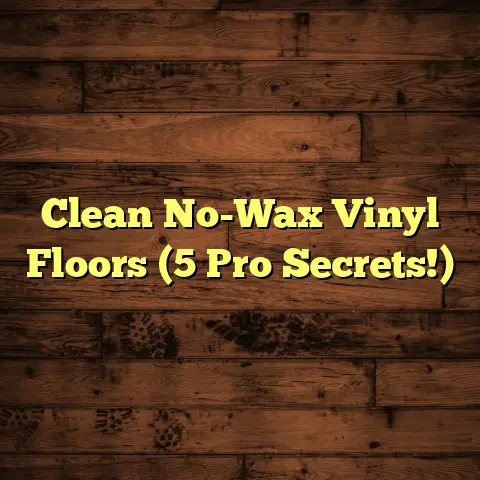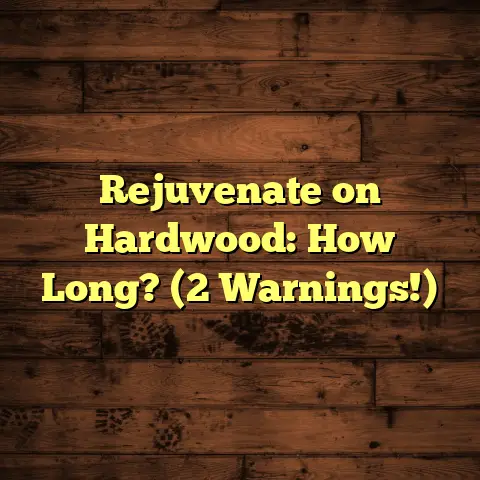Why Old Floors Squeak? (4 Subfloor Fixes Now!)
Did you know that approximately 70% of homeowners report experiencing squeaky floors at some point in their lives?
This common yet often overlooked issue can be not only annoying but also indicative of deeper problems within your home’s structure.
As a flooring contractor with years of experience, I’ve seen firsthand how squeaky floors can drive people crazy.
But more importantly, I know that those squeaks often signal underlying problems with the subfloor or joists.
In this article, I’m going to explore the reasons behind squeaky floors and present four effective fixes for subfloor issues. Let’s dive in and get those floors quiet!
Understanding the Mechanics of Squeaky Floors
Definition and Causes
What exactly are squeaky floors? Simply put, they’re floors that make a noticeable creaking or squeaking sound when you walk on them.
It’s a tale as old as time, or at least as old as your house!
These sounds usually occur when parts of the flooring rub against each other or against the subfloor beneath.
So, what causes this annoying symphony? Let’s break it down:
-
Age of the Flooring: Just like us, floors age! Over time, materials can dry out, warp, and loosen, leading to increased friction and noise.
-
Changes in Humidity and Temperature: Wood is a natural material that expands and contracts with changes in humidity and temperature. This movement can loosen fasteners and create gaps where squeaks can occur. I’ve seen floors go from silent to singing a chorus of squeaks after a particularly humid summer.
-
Foundation Settling: As your home settles, it can put stress on the floor structure. This can cause movement and friction, resulting in squeaks.
-
Improper Installation: Sometimes, the squeaks are baked in from the start. Poor installation practices, like using insufficient fasteners or failing to properly level the subfloor, can lead to squeaky floors down the road. I’ve seen some real doozies in my time!
Key Components
To really understand why floors squeak, it’s important to know the key players:
-
Flooring: This is the surface you walk on – whether it’s hardwood, laminate, tile, or carpet. It’s the star of the show, but it can’t perform without a good supporting cast.
-
Subfloor: This is the structural layer beneath the flooring, usually made of plywood or OSB (oriented strand board). It provides a solid base for the flooring and is crucial for preventing movement and noise.
-
Joists: These are the horizontal beams that support the subfloor. They run parallel to each other and are typically made of wood. Think of them as the backbone of your floor.
These components work together as a team. When they’re properly installed and maintained, they create a solid, silent floor.
But when wear and tear set in, or when moisture levels fluctuate, problems can arise.
The connection points between these components – where the flooring meets the subfloor, and where the subfloor meets the joists – are the most common spots for squeaks to develop.
Why? Because that’s where the friction happens.
Imagine it like this: every time you step on the floor, there’s a tiny bit of movement.
If the fasteners are loose, or if the wood is rubbing against something, you’ll hear that telltale squeak.
The Impact of Squeaky Floors on Homeowners
Annoyance Factor
Let’s be honest, squeaky floors are annoying! They can disrupt your peace and quiet, especially in bedrooms or living rooms.
I’ve had clients tell me they feel like they’re living in a haunted house because of the constant creaking.
One homeowner told me, “It’s like I’m walking on eggshells all the time. I’m constantly trying to avoid the squeaky spots!”
Another said, “I can’t even sneak into the kitchen for a midnight snack without waking up the whole house!”
It might sound funny, but the truth is that squeaky floors can really impact your quality of life.
Potential Structural Concerns
While squeaky floors are often just a nuisance, they can sometimes indicate more serious problems.
Persistent squeaking could hint at compromised joists or weakened subflooring.
If the joists are damaged or sagging, it can cause the subfloor to flex and rub against the flooring, leading to squeaks.
Similarly, if the subfloor is rotting or delaminating, it can lose its ability to support the flooring properly, resulting in movement and noise.
According to the American Society of Home Inspectors, “Unusual sounds in a home, including squeaky floors, should always be investigated to rule out potential structural issues.”
It’s always a good idea to have a professional inspect your floors if you notice persistent or worsening squeaks.
Psychological Effects
You might not think that squeaky floors can have a psychological impact, but they can.
Living with constant noise can be mentally draining, especially in quiet settings like bedrooms.
The constant creaking can disrupt your sleep, make it difficult to concentrate, and generally increase your stress levels.
I’ve seen clients who were so bothered by their squeaky floors that they avoided certain areas of their homes altogether.
The good news is that you don’t have to live with squeaky floors! There are several effective fixes you can try to silence those annoying sounds.
Subfloor Fix 1: Lubrication Techniques
Overview
One of the simplest and most effective ways to mitigate squeaking is to lubricate the joints and gaps between the flooring and subfloor.
Lubrication reduces friction, which in turn reduces noise. It’s like putting oil on a rusty hinge – it can make a big difference!
Materials Needed
There are several common lubricants you can use:
-
Talcum Powder: This is a classic choice for squeaky floors. It’s inexpensive, easy to apply, and effective at reducing friction.
-
Soap (Bar or Powdered): Soap can also be used as a lubricant. Bar soap can be rubbed directly onto the squeaky area, while powdered soap can be applied like talcum powder.
-
Silicone Spray: Silicone spray is a synthetic lubricant that’s especially effective for hard-to-reach areas. It’s also water-resistant, so it can be a good choice for bathrooms or kitchens.
Step-by-Step Process
Here’s how to apply lubricants effectively:
-
Identify the Squeaky Area: Walk around the room and pinpoint the exact location of the squeak.
-
Apply Lubricant:
-
Talcum Powder: Sprinkle a generous amount of talcum powder over the squeaky area. Use a soft brush or cloth to work the powder into the cracks and gaps between the floorboards.
-
Soap: Rub a bar of soap directly onto the squeaky area, focusing on the edges of the floorboards. For powdered soap, apply it like talcum powder.
-
Silicone Spray: Insert the nozzle of the spray can into the cracks and gaps and apply a short burst of silicone spray. Be careful not to overdo it, as silicone spray can be slippery.
-
-
Test and Repeat: Walk over the area to see if the squeak is gone. If not, repeat the application process. You may need to apply the lubricant several times to completely eliminate the noise.
Pro Tip: For best results, apply the lubricant from both above and below the floor, if possible. This may require access to the basement or crawl space.
Subfloor Fix 2: Shimming
What is Shimming?
Shimming is the process of inserting thin pieces of material (shims) into gaps between the subfloor and joists to provide additional support and prevent movement.
It’s like giving your floor a little boost where it needs it most.
Identifying Areas to Shim
The first step is to identify the areas where the subfloor is loose or where there are gaps between the joist and subfloor.
You can do this by walking around the room and feeling for soft spots or areas that flex when you step on them.
You can also use a flashlight to inspect the subfloor from below (if you have access to the basement or crawl space).
Look for gaps between the subfloor and joists, or for areas where the subfloor is sagging.
How to Shim
Here’s a step-by-step process for installing shims:
-
Gather Your Materials: You’ll need shims (thin pieces of wood or plastic), wood glue, and a hammer.
-
Prepare the Area: Clean the area around the gap with a brush or vacuum to remove any debris.
-
Apply Glue: Apply a generous amount of wood glue to both sides of the shim.
-
Insert the Shim: Carefully insert the shim into the gap between the subfloor and joist. Use a hammer to gently tap the shim into place until it’s snug.
-
Trim the Shim: Once the glue has dried, use a utility knife or saw to trim any excess shim material that’s sticking out.
-
Secure the Subfloor: To further secure the subfloor, you can drive screws through the subfloor and into the joist. Use screws that are long enough to penetrate the joist by at least 1 inch.
Pro Tip: If you’re working in a tight space, you can use a shim driver tool to make it easier to insert the shims.
Subfloor Fix 3: Screwing Down Floorboards
Importance of Secure Fastening
Loose floorboards are a major contributor to squeaking. When the floorboards aren’t securely fastened to the subfloor, they can move and rub against each other, creating noise.
Screwing down loose floorboards is a simple and effective way to minimize movement and silence those squeaks.
Tools and Materials
Here’s what you’ll need:
- Drill: A power drill with a screwdriver bit.
- Screws: Wood screws that are long enough to penetrate the subfloor by at least 1 inch.
- Countersink Bit: This will create a small recess for the screw head, so it sits flush with the surface of the floor.
- Wood Filler (Optional): If you want to hide the screw holes, you can use wood filler to fill them in.
Installation Steps
Here’s how to properly screw down loose floorboards:
-
Locate the Squeaky Area: Walk around the room and identify the exact location of the squeak.
-
Drill Pilot Holes: Use the drill and a small drill bit to drill pilot holes through the floorboard and into the subfloor. This will make it easier to drive the screws and prevent the wood from splitting.
-
Countersink the Holes: Use the countersink bit to create a small recess for the screw head.
-
Drive the Screws: Insert the screws into the pilot holes and drive them in until the screw heads are flush with the surface of the floor.
-
Fill the Holes (Optional): If you want to hide the screw holes, use wood filler to fill them in. Let the filler dry completely, then sand it smooth.
Pro Tip: When screwing down floorboards, be sure to space the screws evenly and avoid over-tightening them. Over-tightening can strip the screws or damage the wood.
Subfloor Fix 4: Installing a New Layer of Subfloor
Understanding When to Replace
Sometimes, the existing subfloor is so damaged or deteriorated that it’s more effective to install a new subfloor rather than trying to fix the old one.
Here are some scenarios when replacement is the best option:
-
Extensive Water Damage: If the subfloor has been exposed to water for a long period of time, it may be rotted or delaminated.
-
Widespread Mold Growth: Mold can grow on damp subfloors, causing health problems and structural damage.
-
Severe Sagging or Warping: If the subfloor is severely sagging or warped, it may not be able to support the flooring properly.
Selecting Materials
There are several different types of subfloor materials you can choose from:
-
Plywood: This is a common choice for subfloors. It’s strong, durable, and relatively inexpensive.
-
OSB (Oriented Strand Board): This is another popular choice. It’s similar to plywood but is made from smaller pieces of wood that are glued together.
-
Cement Board: This is a good choice for bathrooms or kitchens, as it’s water-resistant.
Installation Procedure
Here’s a thorough guide on how to install a new subfloor:
-
Remove the Existing Flooring: Start by removing the existing flooring, including any underlayment.
-
Inspect the Joists: Check the joists for any damage or rot. If you find any problems, repair or replace the joists as needed.
-
Measure and Cut the Subfloor: Measure the area and cut the subfloor panels to size.
-
Install the Subfloor: Lay the subfloor panels over the joists, making sure to stagger the seams. Leave a small gap (about 1/8 inch) between the panels to allow for expansion and contraction.
-
Fasten the Subfloor: Use screws or nails to fasten the subfloor panels to the joists. Space the fasteners about 6 inches apart along the edges of the panels and 12 inches apart in the field.
-
Sand the Subfloor: Once the subfloor is installed, sand it smooth to remove any bumps or ridges.
Pro Tip: When installing a new subfloor, be sure to follow the manufacturer’s instructions carefully.
Conclusion
Squeaky floors are a common problem, but they don’t have to be a permanent one.
By understanding the causes of squeaky floors and taking action to address the underlying issues, you can silence those annoying sounds and enjoy a quieter, more comfortable home.
I’ve shared four effective fixes for subfloor issues:
- Lubrication Techniques: Simple and effective for reducing friction.
- Shimming: Provides additional support to loose areas.
- Screwing Down Floorboards: Minimizes movement and noise.
- Installing a New Layer of Subfloor: The best option for severely damaged subfloors.
Don’t let squeaky floors drive you crazy! Take action today to enhance your living environment and potentially improve the value of your home.
Remember, a little effort can go a long way in silencing those squeaks and restoring peace and quiet to your home.





